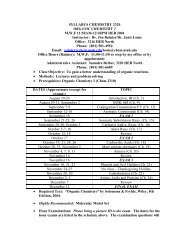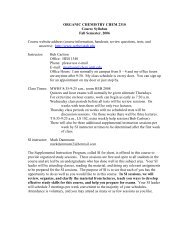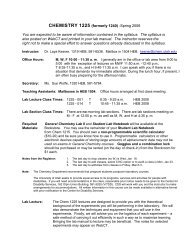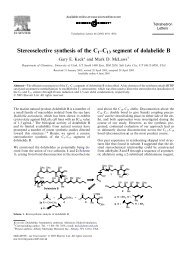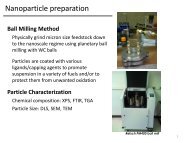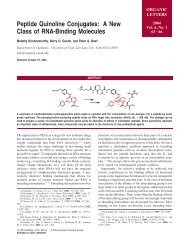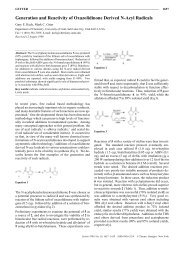Mitsunobu reactions of nucleoside analogs using ... - UC Davis
Mitsunobu reactions of nucleoside analogs using ... - UC Davis
Mitsunobu reactions of nucleoside analogs using ... - UC Davis
Create successful ePaper yourself
Turn your PDF publications into a flip-book with our unique Google optimized e-Paper software.
3154 E. A. Véliz, P. A. Beal / Tetrahedron Letters 47 (2006) 3153–3156<br />
Scheme 1.<br />
initially chose triphenyl phosphite. However, no product<br />
was obtained. We reasoned that a more nucleophilic,<br />
but sterically hindered, phosphite might be needed,<br />
and repeated the reaction <strong>using</strong> triisopropyl phosphite<br />
(TIP). As a model system, substrate 1 was allowed to<br />
react with a series <strong>of</strong> alcohols under <strong>Mitsunobu</strong> conditions<br />
(Table 1). 20 Data presented in Table 1 indicate that<br />
activated alcohols gave good to excellent yields <strong>using</strong><br />
DEAD or DIAD in THF or dioxane as solvents at<br />
50 °C (entries 1–4, and 7). Increasing the steric hindrance<br />
at the ortho position did not affect the reactivity<br />
<strong>of</strong> the alcohol (entries 2 and 3). However, unactivated<br />
alcohols and more hindered activated alcohols (entries<br />
5, 9, and 10) did not form the desired product.<br />
Next, we studied different combinations <strong>of</strong> azodicarboxylate<br />
reagent/solvent for the optimization <strong>of</strong> the reaction<br />
conditions. Consequently, 4-trifluoromethylbenzyl<br />
alcohol was allowed to react under different conditions<br />
according to Table 2. We found that DEAD or DIAD<br />
in THF were the best combinations for this reaction.<br />
The new reagent N,N,N 0 ,N 0 -tetramethylazodicarboxamide<br />
(TMAD), which was developed to be used with<br />
weak acids, gave traces <strong>of</strong> the desired product. 16–18<br />
In addition to the use <strong>of</strong> phosphites in the <strong>Mitsunobu</strong><br />
reaction, we explored the utility <strong>of</strong> this type <strong>of</strong> reagent<br />
in the Véliz–Beal bromination procedure. 15,19 Our protocol<br />
calls for the use <strong>of</strong> hexamethylphosphorous triamide<br />
(HMPT), which is an expensive reagent and has<br />
precluded the use <strong>of</strong> this procedure on large scales. We<br />
found that substituting HMPT for triphenyl phosphite<br />
gave the desired bromo derivative in 76–82% yield<br />
(Scheme 2). However, the reaction took longer to go<br />
to completion (5 h instead <strong>of</strong> 1.5 h) and 5 equiv <strong>of</strong> triphenyl<br />
phosphite were needed instead <strong>of</strong> 2 equiv <strong>of</strong><br />
HMPT. To our surprise, no product was observed when<br />
the 2-acetamido derivative was used.<br />
In conclusion, we have demonstrated the use <strong>of</strong> triisopropyl<br />
phosphite in the <strong>Mitsunobu</strong> reaction as an alternative<br />
to phosphine reagents. Activated alcohols reacted<br />
well and DIAD/THF or DEAD/THF gave the best<br />
results as reagent systems. The formation <strong>of</strong> phosphate<br />
as by-product simplifies its purification due to its higher<br />
solubility in water. More experiments are being<br />
conducted in our laboratories to further study the<br />
scope <strong>of</strong> this reagent system and will be published in<br />
due time.<br />
Table 1.<br />
R Azo derivative Solvent Time (h) Yield (%)<br />
Benzyl DIAD Dioxane 5 95<br />
2-BrBn DIAD Dioxane 18 97<br />
2-BrBn DEAD THF 24 97<br />
p-CF 3 -Bn DIAD THF 24 95<br />
1-Ph–ethanol DIAD Dioxane 24 NR<br />
DIAD Dioxane 24 NR<br />
DIAD THF 24 85<br />
DTAD Dioxane 24 Incomplete<br />
DIAD THF 24 NR<br />
2-Butanol DIAD Dioxane 5 NR<br />
Ref. 20.




